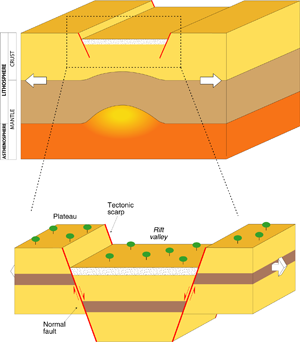Rift
valley: definition and geologic significance
In the original definition
by John W. Gregory (1894) a rift valley is "a linear valley
with parallel and almost vertical sides, which has fallen owing
to a series of parallel faults". The typical morphology
is characterized by a valley floor, between 30 and 100 km wide,
separated from the surrounding plateaus by huge scarps that
may vary in height from a few hundreds to a few thousands of
meters. Archetype of this morphology is the East African rift
valley, where the concept has been originally introduced. In
this region the rift valley extends in a roughly north-south
direction from the Afar depression, where the system of tectonic
troughs joins the oceanic domains of the Red Sea and Gulf of
Aden, to the Zambezi river in Mozambique.

John
Gregory's 1920 map of the East African rift valley (click for
a larger version)
The rift valleys are enormous
fractures affecting the continental plates that widen progressively
with time: they represent the first stages in the complex process
of extension and rupture of continents and anticipate the development
of new oceanic basins between them. The process is related to
the divergent movements of lithospheric plates above the underlying
asthenosphere in slow convective motion. The rift valley represents
the primary and most superficial response to this divergence
and to the consequent application of tensional forces to the
plates, which is manifested through the development of normal
faults. These represent fractures with vertical displacement
of the Earth's surface that accommodate the separation of portions
of the crust and determine the collapse of the block in between.
Major normal fault systems thus give rise to the downthrowing
of the valley floor with respect to the surrounding plateaus
and form the huge tectonic escarpments bordering the rift valley.
These tectonic movements give rise to a diffuse seismicity and
volcanism, phenomena that are typically associated with the
African rift valleys.

Rift
valley development (click for a larger version)
The development of the rift
valleys is thus a consequence of the complex interactions between
lithospheric plates and mantle dynamics, in a process that was
realized by Alfred Wegener, who hypothesized the translation
of large continental masses above a more fluid substratum, and
successively formalized in the theory of "plate tectonics".
These complex interactions, their surface expressions (e.g.,
volcanism, seismicity, topography) and their variation with
time -in a process that is eventually able to the break-up of
continents- are exemplified in a very clear fashion in the Ethiopian
rift valley, as illustrated by its geologic evolution.

